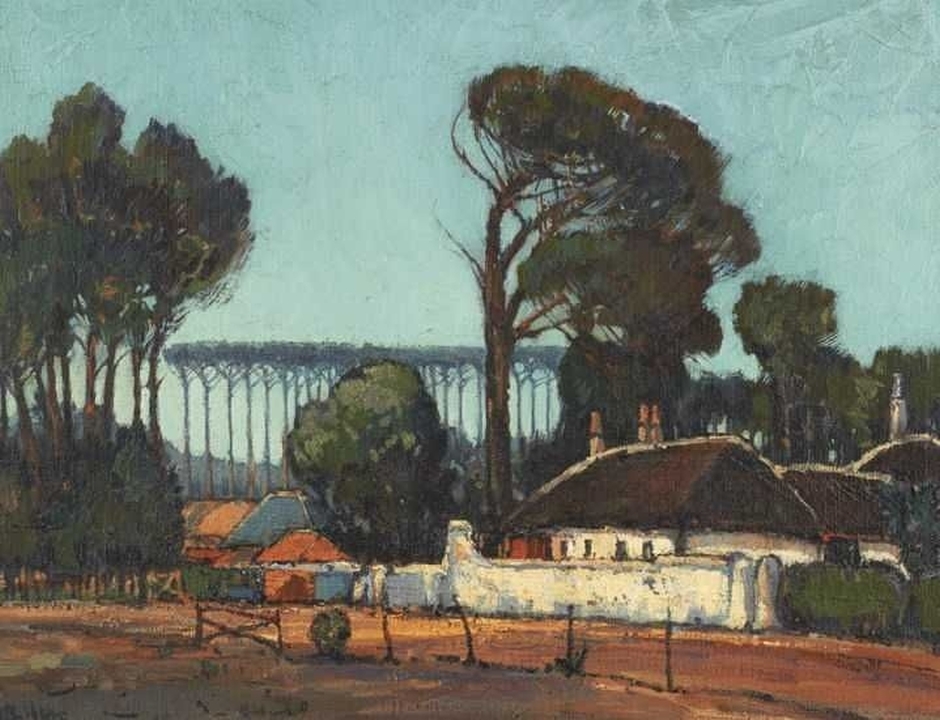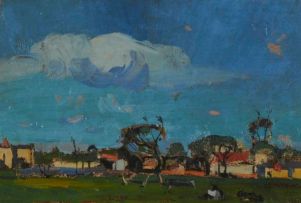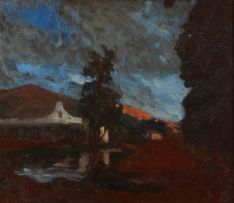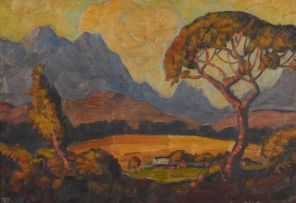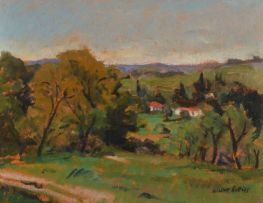Important South African Paintings, Furniture, Silver, Ceramics and Glass
Live Auction, 7 March 2011
Paintings
Incl. Buyer's Premium & VAT
About this Item
signed, inscribed with the title on the reverse
Notes
This remarkable image of Claremont was painted by Pieter Wenning in 1919. At the time the artist was lodging at the Vineyard Hotel, as J. Du Preez Scholtz informs us in his detailed record of Wenning's life as traced through D. C. Boonzaier's diary. Unable to pay for his board, the artist appealed to Boonzaier, his mentor, friend and greatest supporter throughout his life. Leading businessman and Member of Parliament, Dr William Duncan Baxter, came to the artist's rescue when he acquired two paintings, one of which - the companion piece to this - is illustrated on page 133.i Baxter clearly had a passion for the arts and it was as a result of the generous bequest in his will that the Baxter Theatre was established which, in his words, would "develop and cultivate the arts in Cape Town and the adjacent districts".
Both scenes are painted from The Grove, a farm also known as Veldhuysen or Feldhausen in what is now Claremont. The property was acquired in 1834 by Sir John Herschel, the astronomer. It was here that he set up his reflector and observed the southern skies as well as the return of Comet Halley. From 1834 to 1838 he and his wife Margaret produced over one hundred botanical illustrations of fine quality, showing the Cape flora. These were collected and published as Flora Herscheliana in 1998.
The young naturalist Charles Darwin visited Herschel on 3 June 1836. Later on, Darwin would be influenced by Herschel's writings in developing his theory advanced in The Origin of Species. In the opening lines of that work, Darwin writes that his intent is "to throw some light on the origin of species - that mystery of mysteries, as it has been called by one of our greatest philosophers", referring to Herschel.
The Grove provided an ideal retreat from the pressures under which Herschel found himself in London, where he was one of the most sought-after of all British men of science. It was, he later recalled, probably the happiest time in his life. The present day Grove Avenue is named after the farm and Herschel Girls' School takes its name from its illustrious occupant.
Wenning's painting depicts in the foreground the thatched cottages so characteristic of the area at the time. The whitewashed wall surrounding the homestead skilfully leads the viewer's eye into the middle distance enclosed by tall pine trees. The repetition of tree trunks, reminiscent of the graphic qualities of the Japanese woodcuts that Wenning so admired, provides an elegant frame to the rustic foreground scene.
As Hans Fransen has pointed out the cottages are the typical mid-nineteenth-century "Cape-English" variety that characterised early suburban Cape Town, a cottagey variation of Cape Dutch, smaller-scaled, lower, and with hipped thatch roofs instead of gables. Precisely because they were built in what were later to become our present-day suburbs -Rondebosch, Claremont - and therefore had to make way for more modern structures, they are now very rarely found, except in Wynberg's "Little Chelsea".ii
i. J. Du P. Scholtz, D. C. Boonzaier en Pieter Wenning: Verslag van 'n Vriendskap, Tafelberg Publishers, Cape Town, 1973, p. 133 and illus. 118.
ii. Hans Fransen in conversation with Emma Bedford and emails dated 7 January 2011.
Provenance
A gift from the artist to the current owner's grandparents
Literature
cf. J du P Scholtz, DC Boonzaier en Pieter Wenning: Verslag van 'n Vriendskap, Tafelberg, Cape Town, 1973, p 133, illus nos 117 and 118, both from Grove Avenue, Claremont, which relate closely to this work.
